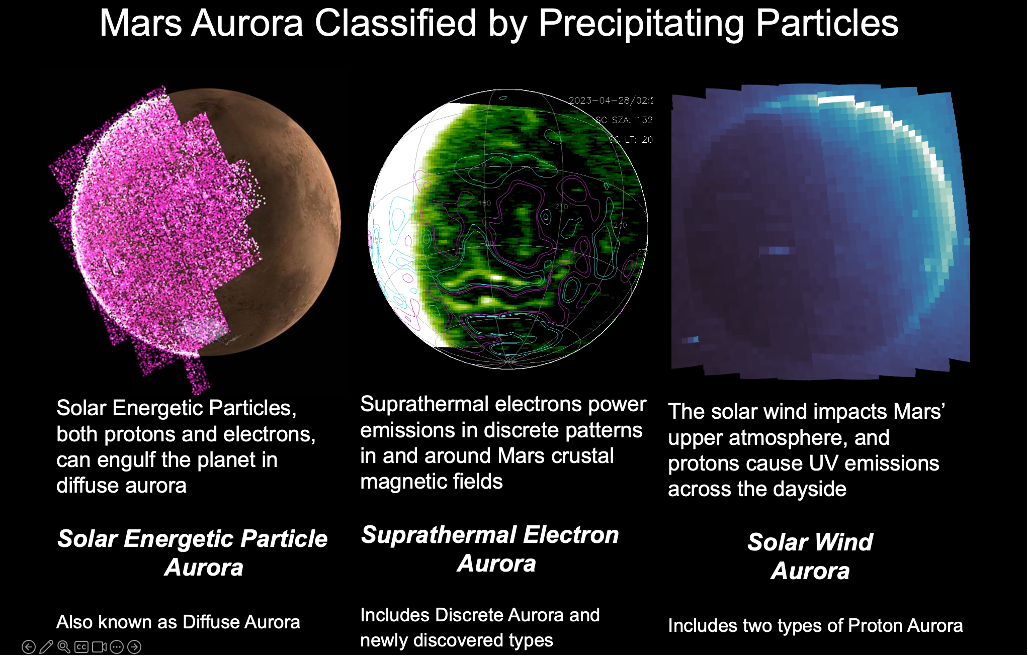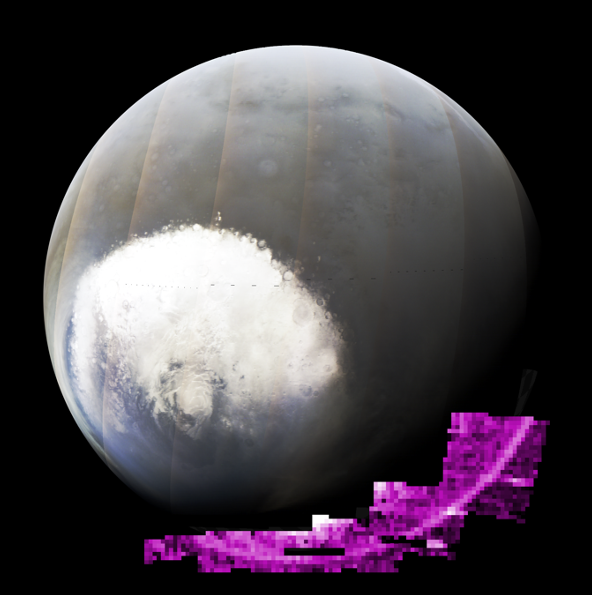- 1LASP, U. Colorado
- 2SSL/Berkeley
Introduction
Mars’ lack of a global magnetic field led to low expectations for auroral phenomena on the planet, but MAVEN observations showed auroral activity to be frequent, diverse in nature, and often global in scope. Subsequent observations by the Emirates Mars Mission [1] further expanded the breadth of observable types of aurora, and it is likely that the variety will increase further as observations expand. Figure 1 below shows three fundamentally different types of aurora on Mars. Ironically, Mars’ lack of a global field is actually responsible for most of the activity, which leads to a new perspective for non-magnetized objects in our solar system and beyond.
Making Sense of Diverse Auroral Activity
Each of type of Mars aurora is a tracer for a different important process involving the interaction between solar influences and the near-Mars magnetic and charged particle environment. Originally, types of aurora were named for their resemblance to terrestrial or other types, with later forms named after their morphology, geographical location, precipitating particles, etc. The nomenclature became cumbersome, confusing, and not insightful to those not working in the field. At the same time, modeling showed that all types could fit into three categories based on the precipitating particles and their origins: solar energetic particles (SEPs), suprathermal electrons, and solar wind protons (see Figure 1). These distinctions usefully group the phenomena into clusters of phenomena observed and modelled similarly, and also allow for new varieties to be added.

Figure 1. Three types of aurora on Mars, as observed by the Imaging UltraViolet Spectrograph (IUVS) on MAVEN (left and right images) and the Emirates Ultraviolet Spectrometer (EMUS) on the Emirates Mars Mission (center image). Each is diagnostic of a specific interaction between solar or internal influences and Mars’ magnetic and plasma environment.
SEP Aurora on the Rise to Solar Max
This presentation will focus on SEP aurora, the type of aurora most dependent on solar activity. MAVEN/IUVS discovered that the entire visible nightside of Mars can be engulfed in auroral emissions [Figure 1, left, and reference 2]. The phenomenon can also be studied in limb scan mode, which revealed that
solar energetic particles can penetrate down to ~60 km altitude. Contemporaneous MAVEN/SEP observations of electrons up to 200 keV confirmed the correlation with solar activity. Some diffuse aurora events have been observed to last for days during extended solar events. Both SEP protons and electrons can be responsible [3].
SEP aurora events are currently occurring at the highest frequency of MAVEN’s 10 year mission. The phenomenon was discovered in 2014 during the declining phase of the solar cycle, and only two additional major events occurred in the following 7 years. Since August 2022, IUVS has observed 8 major events, half of which have occurred since February 2024 (Figure 2). (Additional SEP activity did occur throughout this period, but observations at those other times were not possible.) All auroral events are closely correlated with the arrival of SEP particles as measured by MAVEN’s SEP instrument.

Figure 2. MAVEN/IUVS image of SEP aurora (also known as diffuse aurora) on 18 March 2024 during a space weather event. Both the bright limb and on-disk emission are attributed to auroral emission. The near-UV image of Mars’ south polar region in southern spring was obtained contemporaneously with the auroral portion of the image by alternating detector gain during nadir scanning.
The substantial dataset of recent events will be ideal for comparative studies to determine (1) whether protons or electrons are responsible, and which energy ranges matter most; (2) how Mars’ hybrid magnetosphere responds to the SEP flux, and whether the auroral brightness is modulated by local structures or crustal magnetic fields.
In additional to auroral science goals, our efforts aim to quantify how aurora can serve as a proxy for space weather hazard for human exploration of Mars. This leads to the ironic situation where the aurora may be so impressive it’s necessary to seek shelter against the radiation.
Reaching Solar Max does not imply that auroral activity will soon decrease. In fact, the type of solar activity giving rise to SEP events may increase in the declining phase, with more burst of SEP aurora. MAVEN’s potential mission extension will be able to test this hypothesis.
The Case for Visible Nightside Imaging from Orbit.
Visible wavelength emissions are predicted to accompany UV emissions from SEP aurora, based on atomic and molecular physics with known branching ratios [4]. Oxygen green line emission is expected at 557 nm, as frequently seen at Earth. Brightnesses are expected to be detectable with visible wavelength cameras capable of long exposures. No orbital instruments on existing spacecraft have yet made detections, probably due to sensitivity limits in short exposures.
Future Mars missions with instruments designed for nightside imaging offer tremendous low-cost potential for breakthrough observations in auroral science. Visible filter imaging of the aurora with conventional technology is likely to be orders of magnitude more sensitive than the complex and expensive slit-scanning spectral imagers in orbit at Mars today. In addition to the [OI] green line emission, SEP aurora should also cause emission near the blue end of the visible range, emanating from the FDB bands of CO2+. The recent discovery of visible-wavelength nightglow [5] offers another compelling target for nightside imaging. The M-MATISSE mission, currently in a competitive Phase A Study for an ESA M-class mission, carries such a camera [6] . Even if selected, missions beyond should also carry low-cost visible imagers optimized for the orbit, observational capabilities and science goals of the mission.
References: [1] Lillis et al. (2022), GRL, doi: 10.1029/2022GL099820; [2] Schneider, et al. (2018). GRL, doi: 10.1029/ 2018GL077772. [3] Nakamura et al. (2020), JGR, doi: 10.1029/2021JA029914; [4] Gérard et al., (2015) JGR. 120, 6749–6765 doi: 10.1002/ 2015JA021150; [5] Gerard et al., Nat. Astr., 10.1038/s41550-023-02104-8; [6] Sanchez-Cano et al. (2023): doi 10.3389/fspas.2022.1101945
How to cite: Schneider, N., Jain, S., Cessna, J., Connour, K., Deighan, J., Jolitz, R., Lee, C., Larson, D., Rahmati, A., and Curry, S.: Mars Aurora on the Rise to Solar Max, Europlanet Science Congress 2024, Berlin, Germany, 8–13 Sep 2024, EPSC2024-581, https://doi.org/10.5194/epsc2024-581, 2024.